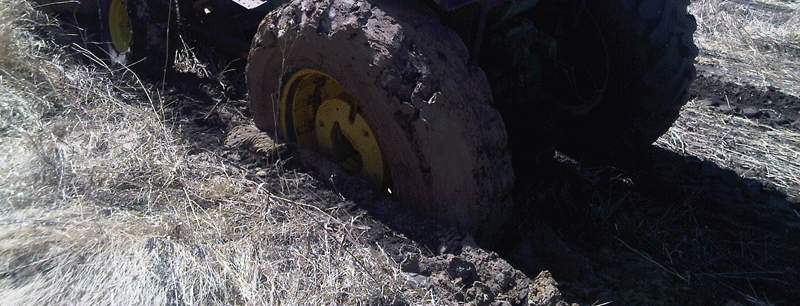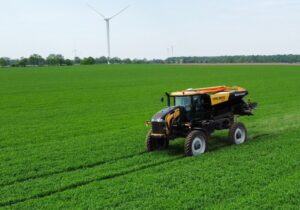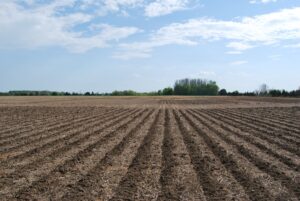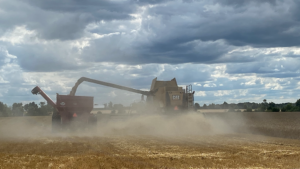The big squeeze on yields
SOIL COMPACTION
WHILE FARMERS KNOW that soil compaction can weigh heavily on yields, many may not realize they have it in their fields or that they may be contributing to the problem.

Dale Cowan, Senior Agronomist with Southern Cooperative Services, says soil compaction is one of those issues that might not be obvious because its impact can resemble other problems like nutrient deficiency or a lack of vigour in the seed.
“What it really comes down to is that it is all about soil quality and creating a root zone that is well-structured, having good drainage, reduced ponding and run-off, and just allowing those roots to grow and take up those nutrients that you’ve invested in,” says Cowan.
He describes soil compaction problems as an unexpected or undesirable outcome when people try to work the fields too soon in the spring. “Perhaps the biggest single factor is being on a wet soil with equipment and it can’t carry the weight,” adds Cowan.
Steve Redmond, a Certified Crop Advisor based in Lucan, believes most farmers will plant when the soil is fit but admits it can be difficult to wait when acres need to be planted.
“Patience is a virtue that they need to have,” says Redmond. “The message is often 48 hours with sun. That extra waiting will often pay off in spades. I think some guys lost 20 or 30 bushels last year.”
Morris Sagriff, an agronomist for DuPont Pioneer, does not mince words when it comes to soil compaction. He has called it agriculture’s biggest enemy and “the number- one yield robber.”
SUBTLE SIGNS
While the subtle signs of compaction beneath the ground are not noticeable, Sagriff notes that they have a significant impact in the form of reduced macroporosity of the soil. This condition leads to slower internal drainage from the micro-pores in the soil, which then takes longer to dry and to warm up.
“It gets down to understanding the dynamics of what constitutes healthy crop production and understanding soil; that it’s a living, viable entity,” says Sagriff, who says knowing when soils are fit to plant is more about the art of farming than the science. “Some years, the earliest planted fields will be the highest-yielding but only if the soils are suitably fit,” says Sagriff.
To help farmers determine if the soils are fit, he recommends digging down two to four inches and grabbing some soil. Sagriff says checking the soil below two inches is important because that is where compression from the equipment will consolidate the soil and restrict potential root growth. If you can make a three or four-inch ribbon of soil between your thumb and forefinger or roll it into a ball, Sagriff says the soil is too wet. Soil that is ready for fieldwork should crumble between your fingers.
“There’s still a question that you could be doing some sidewall smearing but usually not to any degree that it’s going to be serious,” says Sagriff.
In addition to waiting until soil conditions are suitable, other keys to reducing compaction include not running big equipment with inappropriate tire pressures on soils that are moist.
PAST MISTAKES
The crop advisors are also concerned about damage and rutting that was inflicted last fall when the soils were wet. Sagriff says some farmers may want to consider using a light disk and then a field cultivator to smooth out the ruts and ensure level seedbeds.
Redmond says there are some significant issues in soybean fields that weren’t planted with wheat. “You’ll have to level off the ruts. Again, don’t make a second mistake; wait until the land is fit to fill in the ruts.”
Besides restricting root growth, another adverse impact of soil compaction affects soil quality.
“One of the indicators is organic matter, and low-organic matter soils are more easily damaged and impacted because they just lack that ability to have the structure and repair themselves when something goes awry in the field,” says Cowan.
He notes that preserving or increasing organic matter in the soil and having a more diverse crop rotation will help mitigate some damage from compaction over time.
“Any time we can increase the rotation of corn, soybeans, and wheat, for example, we know that has a positive effect on corn and soybean yields, and you have a living root system in the ground for at least 11 months of the year with the wheat,” says Cowan. “And cover crops will do the same sort of thing. It all gets bundled together in a total soil management practice of reducing tillage, selecting the right equipment and air pressures, cover crops and crop rotation for soil quality and higher organic soils.” •







